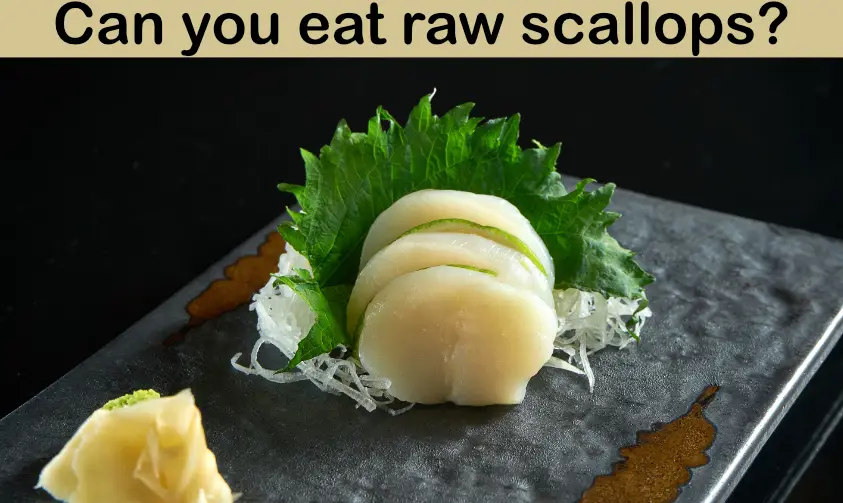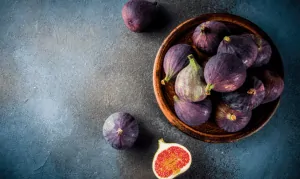A friend raised a question that many people have pondered before: Can you eat raw scallops?
As it turns out, this is one of those questions which is highly debatable. One person could say, “yes” and another could say “no,” both are possible answers.
However, in this article, I will explain to you what you need to know about eating raw scallops, as well as if it is safe or not.

Can you eat raw scallops?
You can eat raw scallops that are fresh and clean. Some people prefer to eat scallops raw to retain the original flavor, but if you’re not sure this is something you like, cook them first.
To really enjoy them, sear the outside to see the browning color then dip it in melted butter or a mustard sauce; this will give it some dimension. It’s best to fry scallops in a pan when preparing them for more than one person–they’ll cook much faster.
What are the benefits of eating raw scallops?
I hope you had a chance to enjoy the delicious scallops at your holiday feast! But if you’re looking for even more ways to eat scallops, no problem! There’s one healthy, scrumptious alternative that I recommend: Eat your scallops raw.
First off, what are some of the benefits of eating raw scallops overcooked ones? For one thing, cooking can cause significant changes in the flavor profile. When scallops are cooked, they take on a nuttier, more buttery flavor. When you eat them raw, however, the ocean flavor and sweetness of the scallop are much more prominent.
Cooking—especially overcooking—also causes scallops to become tough and rubbery. This is due to the collagen in the muscle tissue that breaks down under heat. If you heat the scallops too long or at too high a temperature, they can actually burst in your mouth! The best way to experience the true texture and flavor of a scallop is to enjoy it raw.
Raw scallops are also healthier than their cooked counterparts for one simple reason: Cooking destroys nutrients. Many vitamins and minerals are water-soluble, meaning cooking them can cause them to leech out of the food into the cooking liquid and end up down the drain. Other nutrients, like the antioxidant selenium, are fat-soluble. When cooked in oil or butter, these nutrients actually leech into the cooking medium and become unusable by our bodies.
Don’t worry! The selenium from our delicious scallops is safe and sound. It’s a good reminder, however, that we should be consuming as many of our nutrients as possible in their natural state.
To reap the full nutritional benefits of the selenium in scallops, you should eat them raw. Not only will you get more antioxidants and other nutrients, but also you’ll experience a richer flavor that comes from cooking them at lower temperatures or for shorter amounts of time.
What are the potential risks of eating raw scallops?
Raw scallops are natural food, but there are potential risks involved with raw scallops which you should keep in mind.
- Bacteria: Raw scallops that are not fresh may contain bacteria and other pathogens which can make you very sick (called food borne illnesses).
- Contamination: Raw scallops can be contaminated with harmful bacteria, viruses, parasites, heavy metals, and chemicals (such as pesticides and antibiotic residues). If your scallops are contaminated you’ll likely become ill.
How to enjoy a raw scallop without worries?
If you are planning to eat scallops raw, there are a few important things to keep in mind.
First, make sure the scallops are fresh. These mollusks should smell like the ocean and not have any ammonia odor. U10 scallops are incredibly tender and perfect to be eaten raw along with cold soba noodles.
Second, make sure the scallops are chemical-free. Any scallop that has been treated with chemicals will cause a chemical reaction when it comes in contact with your body.
Also if the scallop has been frozen it should also be thawed first before eating. Using a natural fresh scallop is the best choice to avoid having to worry about chemicals. With natural scallops, there are no added preservatives or chemicals.
Third, clean the scallops well. Scallops that are not cleaned well will make you sick. You should thoroughly wash them with cold water to remove any sand and other debris before eating them raw.
After washing the scallops, they should be soaked in cold water for at least two hours before use.
Finally, they should be rinsed several times with fresh water before eating them raw (Probably as sushi or in a salad)
To summarize, buy scallops that are fresh and clean them properly so you can eat them raw without getting sick.
How to tell if scallops are fresh?
You can easily identify fresh scallops by looking for these five tips:
Tip #1: Check the color
If the scallops are fresh, they will have a pink color else it have a dull brownish color.
Tip #2: Check for an ammonia smell
A good way to tell if scallops are fresh is by smelling them and if there is a strong chemical or ammonia smell then they probably aren’t very fresh.
Tip #3: Check the texture
The texture will be firmer than it should be if they are fresh. But if it is not as firm as you would like it to be, then the scallops probably aren’t very fresh.
Tip #4: Check for any cracks or tears
If there is a tear or crack in the shell, it will make you question their freshness and you should avoid. However if they have a little tear or crack on one side of the scallop and not another, it means that they are probably still good but you should consider them frozen.
Tip #5: Check the thread
The threads (the little fibers that come from the side of the scallop) should not be not dry and brown
The threads should be white and should have a shine to them when you look at them straight up.
What’s the best way to eat a raw Scallop?
If you’ve ever been lucky enough to taste a raw scallop, you know how deliciously salty and sweet the meat is. Tender and velvety, with a delicate flavor of the sea. As a result, raw scallops are often served as an appetizer or aside.
The best way to eat scallops raw is by adding them to your favorite salad. The meat will give it a salty and sweet taste!
Ingredients:
- Fresno Chiles, thinly sliced
- Cucumber, thinly sliced.
- Red onion, thinly sliced.
- Sriracha Sauce (optional) – 2-3 tablespoons. Lime Juice – 2 tablespoons.
- Caesar dressing – 2 tablespoons.
Serves 4 people.
Directions:
Mix lime juice with sriracha and stir well until fully combined. Pour into a bowl and add scallops, onions, chili peppers, and cucumber and mix everything together so the flavors can blend in.
Now pour the Caesar dressing into the bowl and toss everything together thoroughly.
Note: Most people prefer fresh scallops over frozen ones. Fresh scallops are more expensive, but the taste is superior to frozen ones. If you can’t get your hands on fresh scallops, get frozen ones, just make sure they’re as cold as possible. In addition to saving money, it is easier to cook frozen scallops because they won’t fall apart.
Related Question:
Can you freeze uncooked scallops for later use?
You can freeze uncooked scallops for later use by following the below steps.
Step 1:
Prepare them for freezing. The first thing you need to understand is how to prepare scallops for freezing. You may naturally assume that you don’t have to do anything, but you’d be wrong!
You need to remove the muscle from around the sides and bottoms of the scallops before freezing them – otherwise you’ll end up with an incredibly mushy mess when it comes time to use them later on. Luckily, you can do this relatively easily.
put them in a freezer-safe container like a Tupperware; this will keep the moisture out and prevent any kind of damage or compromising.
Step 2:
Freezerize them! Now that they’re clean, dry, and protected in the freezer-safe container, it’s time to put them into the deep freeze (or chill, if you prefer).
Place them right in the middle of the freezer where they’ll be exposed to as little extreme heat as possible; otherwise you’ll end up with bad scallops.
Step 3:
Use them later. When you’re ready to use your frozen scallops, just take them out of the freezer and allow them to thaw (they’ll be fine even if they’re still partially frozen).
Once they’ve thawed, you can cook them in whatever way you like; stir-fry, bake it in foil, sit the scallop on a bed of rice and drizzle it with butter – whatever recipe your heart desires.


